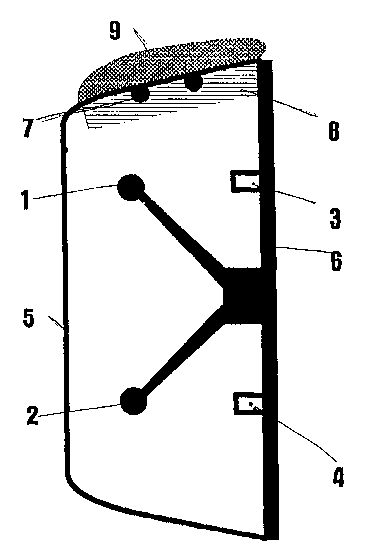Une partie des informations de ce site Web a été fournie par des sources externes. Le gouvernement du Canada n'assume aucune responsabilité concernant la précision, l'actualité ou la fiabilité des informations fournies par les sources externes. Les utilisateurs qui désirent employer cette information devraient consulter directement la source des informations. Le contenu fourni par les sources externes n'est pas assujetti aux exigences sur les langues officielles, la protection des renseignements personnels et l'accessibilité.
L'apparition de différences dans le texte et l'image des Revendications et de l'Abrégé dépend du moment auquel le document est publié. Les textes des Revendications et de l'Abrégé sont affichés :
| (12) Demande de brevet: | (11) CA 2390717 |
|---|---|
| (54) Titre français: | ANTENNE EMETTRICE |
| (54) Titre anglais: | TRANSMITTING ANTENNA |
| Statut: | Réputée abandonnée et au-delà du délai pour le rétablissement - en attente de la réponse à l’avis de communication rejetée |
| (51) Classification internationale des brevets (CIB): |
|
|---|---|
| (72) Inventeurs : |
|
| (73) Titulaires : |
|
| (71) Demandeurs : |
|
| (74) Agent: | GOWLING WLG (CANADA) LLP |
| (74) Co-agent: | |
| (45) Délivré: | |
| (86) Date de dépôt PCT: | 2000-10-30 |
| (87) Mise à la disponibilité du public: | 2001-05-17 |
| Licence disponible: | S.O. |
| Cédé au domaine public: | S.O. |
| (25) Langue des documents déposés: | Anglais |
| Traité de coopération en matière de brevets (PCT): | Oui |
|---|---|
| (86) Numéro de la demande PCT: | PCT/EP2000/010651 |
| (87) Numéro de publication internationale PCT: | WO 2001035486 |
| (85) Entrée nationale: | 2002-05-08 |
| (30) Données de priorité de la demande: | ||||||
|---|---|---|---|---|---|---|
|
La présente invention concerne une antenne émettrice pour systèmes de navigation. Ces antennes sont en règle générale protégées par un radôme contre les influences mécaniques et chimiques des intempéries. Mais lorsque l'antenne est soumise à la pluie, à la glace ou à la neige, le signal d'antenne reçu par des sondes de surveillance est faussé. Pour éliminer le plus largement possible cette influence, la face interne du radôme est couverte, dans la région exposée aux intempéries, par une combinaison d'un réflecteur et d'une couche absorbante.
The invention relates to a transmitting antenna for navigation systems.
Antennae of this type are normally protected against mechanical and chemical
atmospheric influences by a radome. Antenna signals received by the monitor
probe are, however, corrupted by weather-related accumulations on the radome
such as rain, ice or snow. In order to prevent this influence to the greatest
possible extent, a combination consisting of a reflector and of an absorption
layer is applied to the inside of the radome in the area on which rain, ice or
snow is expected to accumulate.
Note : Les revendications sont présentées dans la langue officielle dans laquelle elles ont été soumises.
Note : Les descriptions sont présentées dans la langue officielle dans laquelle elles ont été soumises.

2024-08-01 : Dans le cadre de la transition vers les Brevets de nouvelle génération (BNG), la base de données sur les brevets canadiens (BDBC) contient désormais un Historique d'événement plus détaillé, qui reproduit le Journal des événements de notre nouvelle solution interne.
Veuillez noter que les événements débutant par « Inactive : » se réfèrent à des événements qui ne sont plus utilisés dans notre nouvelle solution interne.
Pour une meilleure compréhension de l'état de la demande ou brevet qui figure sur cette page, la rubrique Mise en garde , et les descriptions de Brevet , Historique d'événement , Taxes périodiques et Historique des paiements devraient être consultées.
| Description | Date |
|---|---|
| Demande non rétablie avant l'échéance | 2004-11-01 |
| Le délai pour l'annulation est expiré | 2004-11-01 |
| Réputée abandonnée - omission de répondre à un avis sur les taxes pour le maintien en état | 2003-10-30 |
| Lettre envoyée | 2002-10-29 |
| Inactive : Notice - Entrée phase nat. - Pas de RE | 2002-10-21 |
| Inactive : Page couverture publiée | 2002-10-17 |
| Inactive : Notice - Entrée phase nat. - Pas de RE | 2002-10-15 |
| Inactive : Demandeur supprimé | 2002-10-15 |
| Inactive : Transfert individuel | 2002-08-21 |
| Demande reçue - PCT | 2002-08-01 |
| Exigences pour l'entrée dans la phase nationale - jugée conforme | 2002-05-08 |
| Demande publiée (accessible au public) | 2001-05-17 |
| Date d'abandonnement | Raison | Date de rétablissement |
|---|---|---|
| 2003-10-30 |
Le dernier paiement a été reçu le 2002-09-09
Avis : Si le paiement en totalité n'a pas été reçu au plus tard à la date indiquée, une taxe supplémentaire peut être imposée, soit une des taxes suivantes :
Veuillez vous référer à la page web des taxes sur les brevets de l'OPIC pour voir tous les montants actuels des taxes.
| Type de taxes | Anniversaire | Échéance | Date payée |
|---|---|---|---|
| Enregistrement d'un document | 2002-05-08 | ||
| Rétablissement (phase nationale) | 2002-05-08 | ||
| Taxe nationale de base - générale | 2002-05-08 | ||
| TM (demande, 2e anniv.) - générale | 02 | 2002-10-30 | 2002-09-09 |
Les titulaires actuels et antérieures au dossier sont affichés en ordre alphabétique.
| Titulaires actuels au dossier |
|---|
| AIRSYS NAVIGATION SYSTEMS GMBH |
| Titulaires antérieures au dossier |
|---|
| ERICH FRANKE |
| HERBERT KLEIBER |
| WOLF-DIETER BIERMANN |